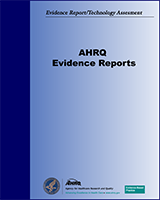This publication is provided for historical reference only and the information may be out of date.
Utility of Blood Pressure Monitoring Outside of the Clinic Setting
Evidence Reports/Technology Assessments, No. 63
Authors
Investigators: Lawrence J Appel, MD, Karen A Robinson, MSc, and Eliseo Guallar, MD, DrPH.ReadStructured Abstract
Objectives:
Ambulatory BP (ABP) and self-measured BP (SMBP) monitoring are two techniques that record frequent BP outside of the clinic setting. The overall objective of this report was to summarize evidence on the clinical utility of ABP and SMBP monitoring.
Search Strategy:
Electronic searches were completed of MEDLINE®, Cochrane Collaboration CENTRAL Register of Controlled Trials, and HealthSTAR. Hand searching was completed of key journals, conference proceedings and references lists. Electronic searching was completed to March 2001, and hand searching was completed to May 2001.
Selection Criteria:
Articles were included in this evidence synthesis if they were English-language reports of original data that addressed one of the specific research questions in nonpregnant adults.
Main Results:
Eighteen studies compared clinic BP, SMBP, and/or ABP. For both systolic and diastolic BP, clinic measurements exceeded SMBP and ABP. Few studies compared SMBP and ABP. Sixteen studies determined the prevalence of white coat hypertension (WCH). Overall, WCH prevalence was approximately 20 percent among hypertensives but varied considerably by definition. Few studies assessed the reproducibility of WCH (two studies) or the reproducibility of differences between clinic BP and either ABP (one study). In cross-sectional studies of BP with left ventricular mass and/or albuminuria (25 studies), ABP levels were directly associated with both measurements; also, left ventricular mass was less in individuals with WCH than in those with sustained hypertension. Ten prospective studies assessed the relationship of ABP with subsequent clinical outcomes. In each study, at least one dimension of ABP predicted outcomes. WCH predicted a reduced risk of CVD events compared to sustained hypertension. However, data were inadequate to compare the risk associated with WCH to the risk associated with normotension. A nondipping or inverse dipping pattern predicted an increased risk of clinical outcomes. The literature was insufficient to determine whether absolute SMBP levels or WCH based on SMBP was associated with left ventricular mass or proteinuria (just one study) or whether SMBP measurements predicted subsequent CVD (just one study). In both cross-sectional and prospective studies, the poor or uncertain quality of clinic measurements precluded a satisfactory comparison of SMBP and ABP with clinic BP. Twelve trials assessed whether use of SMBP had an impact on BP control. In half of these studies, including two trials that tested contemporary devices, use of SMBP was associated with reduced BP. The availability of just two ABP trials limited inferences about the utility of ABP to guide BP management. In general, few studies reported enrollment of African-Americans. Studies infrequently reported results stratified by gender. The only notable subgroup finding was a higher prevalence of WCH in women than men.
Conclusions:
In cross-sectional studies, ABP levels and ABP patterns were associated with BP-related target organ damage. Likewise, in prospective studies, higher ABP, sustained BP, and a nondipping ABP pattern were associated with an increased risk of subsequent CVD events. Few studies examined corresponding relationships for SMBP. An inadequate number of clinic BP measurements, as well as the poor or uncertain quality of these measurements, precluded satisfactory comparisons of risk prediction based on ABP or SMBP with risk prediction based on clinic BP. In aggregate, these findings provide some evidence that ABP monitoring is useful in evaluating prognosis. However, evidence was insufficient to determine whether the risks associated with WCH are sufficiently low to consider withholding drug therapy in this large subgroup of hypertensive patients. For SMBP, available evidence suggested that use of SMBP can improve BP control; however, further trials that evaluate contemporary SMBP devices are needed.
Investigators: Thomas Erlinger, MD, MPH, Syed O Masood, MBBS, MPH, Megan Jehn, MHS, Lee Fleisher, MD, Neil R Powe, MD, MPH, MBA, Eric B Bass, MD, MPH.
Prepared for: Agency for Healthcare Research and Quality, U.S. Department of Health and Human Services.1 Contract No. 290-97-006. Prepared by: Johns Hopkins Evidence-based Practice Center, Baltimore, MD.
Suggested citation:
Appel L, Robinson K, Guallar E. Utility of Blood Pressure Monitoring Outside of the Clinic Setting. Evidence Report/Technology Assessment No. 63 (Prepared by the Johns Hopkins Evidence-based Practice Center under Contract No 290-97-006). AHRQ Publication No. 03-E004. Rockville, MD: Agency for Healthcare Research and Quality. November 2002.
The authors of this report are responsible for its content. Statements in the report should not be construed as endorsement by the Agency for Healthcare Research and Quality or the U.S. Department of Health and Human Services of a particular drug, device, test, treatment, or other clinical service.
- 1
2101 East Jefferson Street, Rockville, MD 20852. www
.ahrq.gov
